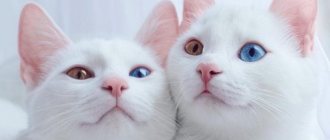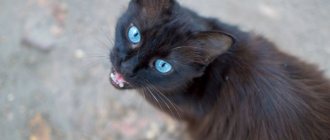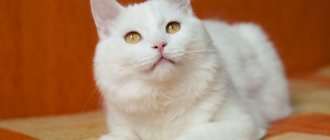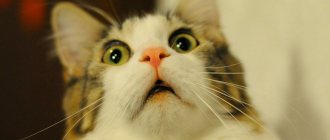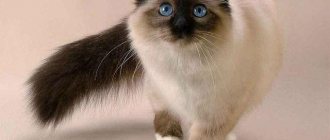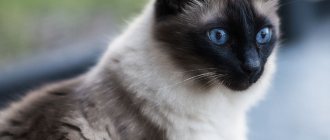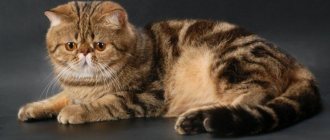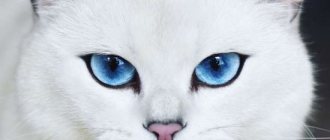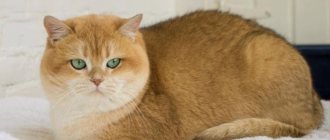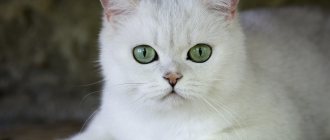A cat with soft, Persian-like, rich brown fur is one of the rarest on the planet. Despite not being recognized by many felinological organizations, the Yorkie cat is winning the love of cat lovers in America and Europe, thanks to its exotic appearance, friendly and balanced character, and unpretentiousness in its maintenance. This affectionate and playful pet is suitable for both a family with children and a single breeder.
History of the breed
In 1983, on a farm near New York, a black and white cat, Blackie, gave birth to a female kitten named Brownie from her smoky gentleman, Smokey. The unusually beautiful chocolate color of the little pet’s fur attracted the attention of the owner of the farm, Janet Chifari. A year later, the woman, having bred a cat, received offspring, in which one of the cubs turned out to be black with a rich brown undercoat. The farmer bred him with his mother cat, resulting in the appearance of a chocolate boy, Teddy Beer, and a white-chocolate girl, Cocoa.
The woman, fascinated by the appearance and character of chocolate cats, began breeding and opened a nursery. In 1989, there were 27 individuals in the nursery. A veterinarian visited the farm and put the owner in touch with CFF felinologist Nancy Belser. A specialist came to the farm to verify the uniqueness of the breed.
The felinologist recommended taking part in the exhibition organized by CFF. In the fall of 1989, Janet brought a chocolate kitten named Prince to the exhibition. The demonstration turned out to be enchanting, the Prince received the highest award in the “Pet” category.
Encouraged, Janet named the breed Yorkie Chocolate and applied for recognition. In 1990, CFF specialists gave the breed an experimental category, and 2 years later it received full recognition. In 1995, the chocolate breed was recognized by Canadian experts and the WCF.
Chantilly
A very rare breed with mysterious origins. Its first representatives were found in a house bought by a British family. There lived two cats whose fur had an amazing chocolate shade.
Source: uf.ru
Subsequently, this breed acquired other interesting colors - cinnamon (cinnamon), golden, black, beige. They also have a very good character - affectionate, friendly and sociable cats can be excellent companions. Interestingly, Chantilly is not the first name of the breed. At first, these cats were supposed to be called “foreign longhair,” but this name was considered too impersonal. The second was “Tiffany” - later they also abandoned it. But “Chantilly” has taken root quite well.
Source: www.royal-canin.ru
Description of cats
The Yorkie cat has a large build, especially in males, as can be seen in the photo. The female weighs 7-8 kg, the male weighs 9-10 kg.
A description of the York Chocolate cat according to the breed standard is given in the table.
| head | medium size, the angle between the nose and forehead is smoothed, the bridge of the nose is slightly arched, the lobe and chin form one line, the neck is elongated |
| eyes | medium-sized, closer to large, almond-shaped, widely spaced, golden or golden-green iris |
| ears | large, widely spaced, wide base, rounded tips |
| torso | elongated, sinewy, non-massive, graceful, classically shaped |
| limbs | medium length, strong, with well-developed muscles |
| tail | long, thin, gradually tapering from base to tip, the coat forms a feather-like shape |
| wool | semi-long, delicate, with a silky sheen, thin hairs, chest is usually decorated with a “collar”, limbs with “pants” |
Color
Yorkie cats have a solid color, without red or darker streaks, tabby patterns, or ticking.
The following colors are available:
- Chocolate solid (solid) – rich brown color. The lobe is dark brown, the pads are pinkish-brown.
- Lilac solid (solid) is a light lavender-brown. The lobe is light brown, the soles of the paws are dark pink.
- Chocolate with white (two-color) - white paws, chest, belly on a main brown background. Spots on the face are acceptable. The nose and pads are brown or brownish-pink.
- Lilac and white (two-color) - on a lilac basis there are white paws, chest, belly. White spots are allowed on the face. The lobe is lilac-pink, the soles are pink or lilac-pink.
Show colors are solid lilac and chocolate. A cat with white spots cannot participate in competitions.
Havana brown
The ancestors of this breed are considered to be Thai and Siamese cats, which were crossed with suitable short-haired species. As a result, Miranda von Ullman, Anne Hargreaves and Mrs. Fisher managed to develop a new breed in the 50s. These cats were first presented at a British exhibition in 1959.
Source: kotsobaka.com
Features of the breed are a narrow head, large ears and green eyes. Their color is quite varied and is represented by shades of brown. These cats are distinguished by high intelligence and exquisite grace. Interestingly, this breed received its name in honor of Cuban cigars due to its similar color.
1111
Character of the breed
Moderate character and temperament are typical for the breed; York cats are gentle, affectionate, affectionate, and sociable. They need human communication and attention, they try to stay close to the owner and observe his troubles. At the same time, the cat is unobtrusive, delicate, and leaves if it sees that the owner is busy or in a bad mood.
The Yorkie breed is characterized by independence, manifested by independence, but not detachment. The Yorkie cat loves to cuddle and lie down on her lap. Loneliness is an unbearable state. Long-term absence of the owner's attention and care leads to depression. Thanks to its innate tact and intelligence, the pet easily adapts to the rhythm and rules of the family, therefore it is suitable for families with children, and for the elderly, and for careerists.
The attitude towards strangers is distrustful, but restrained and non-aggressive. The cat watches the guest from afar for a long time and, making sure that he is safe, comes up to meet him.
The Yorkie breed is suitable for keeping both in a city apartment and in the private sector.
The Yorkie is friendly with children, willingly participates in fun, catches a toy on a string, and maintains a cheerful and playful attitude. Friendly or aloof attitude towards dogs. But you shouldn’t have parrots, hamsters and aquarium fish: Yorkie cats have a developed hunting instinct.
Characteristics of York chocolate cats
Whenever a potential breeder meets his future pet, he wonders what the new furry tenant will be like upon closer communication. What do you need to know about the character and manners of chocolate Yorkies before buying one from a kennel?
- Flexibility of character. The York Chocolate cat, without any problems, is able to adapt to the temperament and rhythm of life of its owners - be it an elderly couple, a young active family with a small child, or an always busy careerist. Yorkie cats are tactful and easy to train.
- Lack of aggression. When a new pet or guest appears in the house, the Yorkie behaves with restraint and politeness. Having looked closely and made sure that there is no danger for them, they willingly make contact with newcomers. But if these are fish, birds or rodents, then first, just in case, it’s better to keep an eye out for a chocolate cat.
- Love of affection without intrusiveness. This breed enjoys the company of household members - it likes attention, and the cat needs it in large quantities. Playing with the owner, having fun with other animals, stroking and scratching - chocolate Yorkies love tactile sensations. They will not bother you if they understand that the person is busy with serious business or is relaxing. However, the Yorkie can follow him “tail” all day, silently, waiting for a moment of entertainment or affection.
To summarize, we can say that a Yorkie cat quickly becomes attached to its owner , surrounding him with a light aura of tenderness. American cats are supporters of moderate but sincere fun and friendship with other animals. In addition, it is worth noting that when communicating with small children, towards whom chocolate Yorkies show the strongest positive emotions, cats behave in the most mannered and careful manner.
Care and maintenance
Yorkie chocolate cats have excellent health and strong immunity. Pets live 12-14 years. The only common health problem is being overweight. Therefore, it is important to properly prepare the diet and not overfeed the animal, otherwise you will have to fight not only obesity, but also indigestion. The best option is to use ready-made super premium food for long-haired cats.
The rest of the cat care is standard and includes:
- Combing once a week (twice during shedding period) using a wide-toothed comb and a massage brush. At the end of the procedure, you need to walk over the body with a damp palm to collect dead hairs.
- Bathing once a month or as needed. Representatives of the chocolate breed love to splash in the water.
- Trimming nails with a nail clipper as they grow. Acceptable grip is at least 2 mm from the pink living part of the claw with blood capillaries.
- Clean the ears weekly with a cotton swab soaked in veterinary ear lotion.
- Daily wiping of tear drains with a cloth moistened with boiled water or veterinary eye lotion.
- To prevent tartar, clean your teeth 2 times a week with a soft brush using a leave-in paste for animals.
- Quarterly anthelmintic treatment.
Since the Yorkie Chocolate is an active breed, regular walking is advisable. A cat living in a private estate can roam freely in the yard. In urban environments, the owner must walk the pet on a leash to avoid any trouble.
Funny and funny nicknames
Read the list of cool names, they will definitely bring back pleasant memories and a smile. May a kitten with one of these funny names always bring you happiness and joy.
Like this little guy named Little Humpbacked Horse.
Choose a funny nickname for your kitten:
- Ava – Cute;
- Bamboo;
- Benji;
- Beaver - Beaver, beaver;
- Brie - cheese;
- Bourbon;
- Woody;
- Duffy "Dark Face";
- Don is a mafia leader;
- Dragon;
- Cake;
- Coconut;
- Cocktail;
- Cognac;
- Corky – cheerful;
- Pretzel;
- Barney Bear;
- Pepsi - soda;
- Brewer Brewster;
- Pierre Bezukhov;
- Radar;
- Rock'n'roll;
- Shogun;
- Slater (Slate);
- Snickers;
- Starbucks;
- Sumo;
- Sushi;
- Sable – sable;
- Tai;
- Taiga;
- Tiki;
- Faun;
- Fox - Little Fox;
- Foxy - Fox;
- Chino;
- Chip;
- Chitta - Monkey;
- Chocky;
- Berry berry.
A cat who is just learning to run is the Speedy Cat.
How to get a kitten
In Russia and the CIS it is impossible to buy a purebred pet. If you see an advertisement for the sale of a chocolate cat, you should not respond: these are scammers offering a mongrel brown or faded black kitten.
The Yorkie breed is not widespread, so you can come across scammers abroad. The buyer should ask the seller for birth certificates, pedigrees of the parents, and a veterinary passport with vaccination records.
The Yorkie Chocolate kitten must meet the breed standard:
- kittens do not have such a rich chocolate color as adults, but the color should be uniform;
- the coat is dense, but soft and delicate, the undercoat is thick;
- iris of the color allowed by the standard;
- the distance between the ears is the width of the base of the auricle;
- the distance between the eyes is the width of one eyeball;
- the muzzle is wedge-shaped, slightly elongated;
- the body is elongated.
A Yorkie kitten that is 2 months old is ready to go to a new family. At this age, he is vaccinated, independent, and able to use the litter tray.
A healthy Yorkie kitten is active, inquisitive, and does not show fear or aggression. The tears do not flow, the ears and anus are free of discharge. The coat is clean, shiny, without traces of skin diseases and parasitic lesions.
Price and nurseries
You can buy a chocolate Yorkie in the USA, England, and Canada. The price is determined by the exhibition category: for a Yorkie Pet (companion) they ask for 400-500 dollars . A chocolate cat breed (for breeding) and show (for exhibitions) will cost up to $1000 .
American and European nicknames
Let's find out what chocolate kittens are called - boys and girls in America and in European countries. The list includes the most fashionable and popular names for pets who wear a brown coat.
This is bored Abby - Abby.
Names for brown girls:
- Angel – Angel (Angel);
- Athena - Esina (Athena);
- Bagheera - Bagheera;
- Belle - Belle;
- Blanche - Blanche;
- Coco - Coco;
- Daisy – Daisy (Chamomile);
- Ella - Ella;
- Fiona - Fiona;
- Izzy - Izzy;
- Jasmine - Jasmine (Jasmine);
- Kali - Kali;
- Kiki – Kiki;
- Kitty - Kitty;
- Layla - Layla;
- Lily - Lilly;
- Lola - Lola;
- Lucy - Lucy;
- Lulu - Lulu;
- Maggie - Maggie;
- Marley - Marley;
- Meatball - Meatball (Meatball);
- Midnight - Midnight (Midnight);
- Millie - Millie;
- Missy - Missy;
- Olivia - Olivia;
- Penny - Penny;
- Pixie - Pixie;
- Princess – Princes (Princess);
- Riley - Riley.
Cautious Panther (Panther) is a male Panther.
Names for brown boys:
- Agent – Agent;
- Archie - Achi (Archie);
- Binx - Binx;
- Bob - Bob;
- Boots - Boots (Boot);
- Bubbles - Bubbles (Bubble);
- Buddy - Badi (Buddy);
- Calvin - Kelvin;
- Charlie - Charlie;
- Clyde - Clyde;
- Cricket - Cricket;
- Fluffy - Fluffy (Fluff);
- Frankie - Frankie;
- Freckles – Freckles (Freckles);
- George - George;
- Gus Gus – Gus Gus;
- Harley - Harley;
- Irony – Irony (Iron);
- Jackson - Jackson;
- Leo - Leo;
- Louie - Louis;
- Lucky - Lucky (Lucky);
- Mittens - Mittens (Mittens);
- Murphy - Murphy;
- Oscar - Oscar;
- Patches - Patches;
- Pebbles - Pebbles (Pebble);
- Pepper - Pepper (Pepper);
- Pip - Pip;
- Piper - Piper.
Graceful Ballet (Ballet).
Features of color
The formation of color is a complex biochemical process that begins in the embryonic stage of embryonic development. The color of a future kitten's fur depends on the interaction of dozens of genes.
- Chocolate color is one of the forms of black, for which the B gene (black) is responsible. In combination bb it gives the color range of a brown monochrome, capable of taking on different tones.
- Next, the D gene enters the process. In the dominant form, it blocks any lightening, but in the recessive version, dd opens the way for a change in the color of the main pigment.
- The bb (brown) allele and the dominant D gene are chocolate color. When the combination bb+dd occurs, the coat lightens and turns purple.
- Black always dominates brown.
- Within colors there are also divisions into tones. Dark chocolate is formed by the b allele, and the lighter cinnamon (cinnamon) received the b index
- Option b partially suppresses b1, making color fixing a very difficult task. Therefore, kittens change color over time, and only in an adult animal can one accurately determine the color of the coat.
- In nature, cats have two coloring pigments - black eumelanin and red pheomelanin. But the first one has two additions - brown (dark chocolate) and cinnamon (cinnamon color). The color saturation of the hair is affected by the shape of the dye capsules and the density of their arrangement in each hair.
